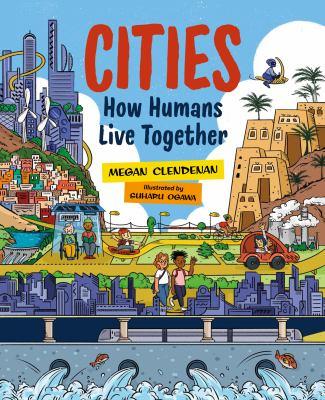
Cities : how humans live together
If you could design a city that would be both a great place to live and good for the planet, what would it look like? Today, about four billion people―more than half the world’s population―live in cities. This number could rise to seven billion by 2050. Cities face big challenges, including threats from climate change, food insecurity, a lack of clean water and rapid population growth, but they are also places where innovation and sustainability can thrive. How Humans Live Together travels through time to explore questions like When and why did cities form? How did people access food and water? Where did they go to the bathroom? Peek into the past to see how cities have changed through time and explore what could make cities more sustainable and welcoming for today and tomorrow.
Available Copies by Location
| Location | |
|---|---|
| Victoria | Available |
Browse Related Items
- ISBN: 9781459831469
- Physical Description 88 pages : color illustrations ; 29 cm.
- Publisher [Place of publication not identified] : [publisher not identified], 2023.
Content descriptions
| Bibliography, etc. Note: | Includes bibliographical references and index. |
| Target Audience Note: | 1100L Lexile |
Series
Additional Information
| LDR | 02210cam a2200385 i 4500 | ||
|---|---|---|---|
| 001 | 262472 | ||
| 003 | NFPL | ||
| 005 | 20230512141332.0 | ||
| 008 | 220624s2023 bcca j b 001 0 eng | ||
| 020 | . | ‡a9781459831469 ‡q(hardcover) | |
| 035 | . | ‡a(OAUW)508624 | |
| 040 | . | ‡aDLC ‡beng ‡erda ‡cDLC ‡dCaOAUW | |
| 082 | 0 | 4. | ‡a307.76 ‡223 |
| 100 | 1 | . | ‡aClendenan, Megan, ‡d1977- ‡0(NFPL)71396 |
| 245 | 1 | 0. | ‡aCities : ‡bhow humans live together / ‡cMegan Clendenan ; illustrated by Suharu Ogawa. |
| 264 | 1. | ‡a[Place of publication not identified] : ‡b[publisher not identified], ‡c2023. | |
| 264 | 1. | ‡a[Victoria, B.C.] : ‡bOrca Book Publishers, ‡c2023. | |
| 300 | . | ‡a88 pages : ‡bcolor illustrations ; ‡c29 cm. | |
| 336 | . | ‡atext ‡btxt ‡2rdacontent | |
| 337 | . | ‡aunmediated ‡bn ‡2rdamedia | |
| 338 | . | ‡avolume ‡bnc ‡2rdacarrier | |
| 490 | 1 | . | ‡aOrca timeline |
| 504 | . | ‡aIncludes bibliographical references and index. | |
| 520 | . | ‡aIf you could design a city that would be both a great place to live and good for the planet, what would it look like? Today, about four billion people―more than half the world’s population―live in cities. This number could rise to seven billion by 2050. Cities face big challenges, including threats from climate change, food insecurity, a lack of clean water and rapid population growth, but they are also places where innovation and sustainability can thrive. How Humans Live Together travels through time to explore questions like When and why did cities form? How did people access food and water? Where did they go to the bathroom? Peek into the past to see how cities have changed through time and explore what could make cities more sustainable and welcoming for today and tomorrow. | |
| 521 | 8 | . | ‡a1100L ‡bLexile |
| 650 | 0. | ‡aCity and town life ‡vJuvenile literature. ‡0(NFPL)114059 | |
| 650 | 0. | ‡aCities and towns ‡vJuvenile literature. ‡0(NFPL)114058 | |
| 650 | 0. | ‡aCity dwellers ‡vJuvenile literature. | |
| 650 | 0. | ‡aUrban ecology (Sociology) ‡vJuvenile literature. | |
| 700 | 1 | . | ‡aOgawa, Suharu, ‡d1979- ‡0(NFPL)72416 |
| 830 | 0. | ‡aOrca timeline. ‡0(NFPL)137531 | |
| 852 | . | ‡aONF ‡bCHIP ‡cJuvenile ‡h307.76 Cle ‡kJ ‡p38080500476385 ‡sJNF ‡tJNF ‡x29.95 ‡zIn process | |
| 904 | . | ‡aMARCIVE 2023 | |
| 905 | . | ‡umhulett | |
| 901 | . | ‡a262472 ‡bAUTOGEN ‡c262472 ‡tbiblio ‡soclc | |

